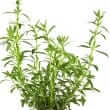Background
- The use of hyssop as an herbal remedy dates back to Biblical times. It is mentioned in both the Old and New Testaments of the Christian Bible as a cleansing agent (although these references may be to other species of hyssop, such as Origanum aegypticum or Origanum syriacum, rather than Hyssopus officinalis).
- Hyssop has been prescribed for a multitude of medical conditions, although there are few high-quality human trials researching these uses. It has been used traditionally as an antispasmodic, expectorant, emmenagogue (stimulates menstruation), stimulant, carminative (digestive aid), peripheral vasodilator, anti-inflammatory, anticatarrhal, antispasmodic, tonic and sweat-inducer. However, both the alcoholic extract and decoction have been used to inhibit sweating. Hyssop is used specifically for cough, bronchitis and chronic catarrh, and also for its tonic effects on the digestive, urinary, nervous and bronchial systems. Hot hyssop decoction vapors have also been used to treat inflammation and tinnitus.
References
Natural Standard developed the above evidence-based information based on a thorough systematic review of the available scientific articles. For comprehensive information about alternative and complementary therapies on the professional level, go to . Selected references are listed below.
- Baek JH, Lee YS, Kang, CM, et al. Intracellular Ca2+ release mediates ursolic acid-induced apoptosis in human leukemic HL-60 cells. Int J Cancer 11-27-1997;73(5):725-728.
View Abstract - Burkhard PR, Burkhardt K, Haenggeli CA,et al. Plant-induced seizures: reappearance of an old problem. J Neurol 1999;246(8):667-670.
View Abstract - Cesarone MR, Belcaro G, Pellegrini L, et al. HR, 0-(beta-hydroxyethyl)-rutosides, in comparison with diosmin+hesperidin in chronic venous insufficiency and venous microangiopathy: an independent, prospective, comparative registry study. Angiology 2005;56(1):1-8.
View Abstract - Deng YY, Chen YP, Wang L, et al. [Clinical study on treatment of mid-advanced crescentic nephritis by qingre huoxue recipe]. Zhongguo Zhong.Xi.Yi.Jie.He.Za Zhi. 2004;24(12):1084-1086.
View Abstract - Es-saady D, Simon A, Ollier M, et al. Inhibitory effect of ursolic acid on B16 proliferation through cell cycle arrest. Cancer Lett. 9-10-1996;106(2):193-197.
View Abstract - Gollapudi S, Sharma HA, Aggarwal S, et al. Isolation of a previously unidentified polysaccharide (MAR-10) from Hyssop officinalis that exhibits strong activity against human immunodeficiency virus type 1. Biochem.Biophys.Res.Commun. 5-5-1995;210(1):145-151.
View Abstract - Hoffmann D. Therapeutic herbalism. A correspondence course in phytotherapy. 1995;4:64-65.
- Jantet G. RELIEF study: first consolidated European data. Reflux assEssment and quaLity of lIfe improvement with micronized Flavonoids. Angiology 2000;51(1):31-37.
View Abstract - Jie L. Pharmacology of oleanolic acid and ursolic acid. Journal of Ethnopharmacology 1-2-1995;49(2-1):57-68.
- Keenoy B, Vertommen J, De Leeuw I. The effect of flavonoid treatment on the glycation and antioxidant status in Type 1 diabetic patients. Diabetes Nutr Metab 1999;12(4):256-263.
View Abstract - Kreis W, Kaplan MH, Freeman J, et al. Inhibition of HIV replication by Hyssop officinalis extracts. Antiviral Res. 1990;14(6):323-337.
View Abstract - Millet Y, Jouglard J, Steinmetz MD, et al. Toxicity of some essential plant oils. Clinical and experimental study. Clin Toxicol. 1981;18(12):1485-1498.
View Abstract - Varga E, Hajdu Z, Veres K, et al. [Investigation of variation of the production of biological and chemical compounds of Hyssopus officinalis L.]. Acta Pharm Hung. 1998;68(3):183-188.
View Abstract







